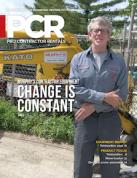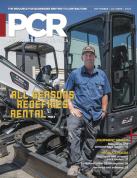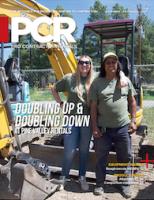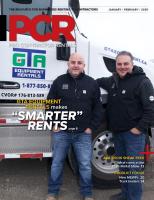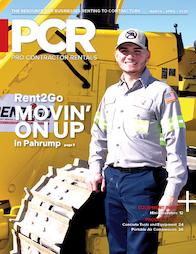Equipment Insight: Tool carriers
Industry experts share how tool-carrying equipment can make safer, more productive job sites.
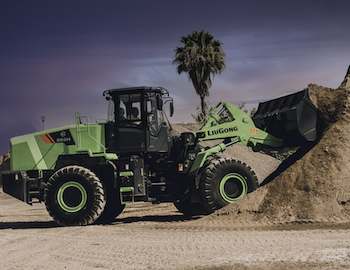 |
|
Correctly sizing a loader to a job site will help maximize productivity. If a jobsite is too tight, an oversized loader could produce slower cycle times. A larger job site may suffer from too small of a loader needing to make extra passes to fill a truck. |
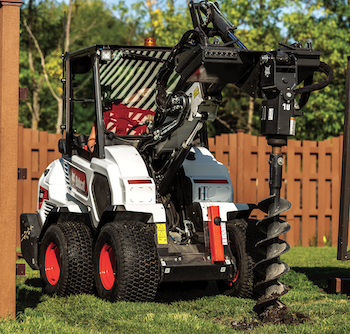 |
|
Post hole digging is one of the many jobs versatile tool carriers can help out on job sites. |
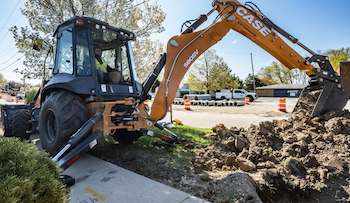 |
|
The new Case 580SV backhoe loader has a hydraulic front coupler available that can work with a very large range of Case attachments, from a 6-in-1 bucket to pallet forks to brooms and more. |
 |
|
The Kubota SVL75-3 comes with a new one-piece sealed cab which is quieter and engineered to keep dust, dirt and water from intruding. Inside the cab, a new 7-inch touch screen includes keyless start, integrated Bluetooth and digital displays for vital gauges. A new wide-angle reversing camera comes standard and offers a 176-degree field of view on the touch screen. |
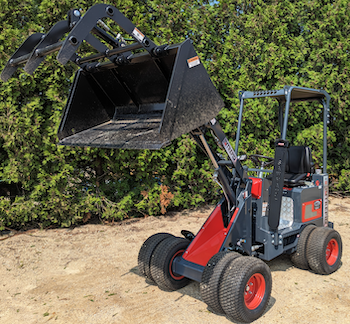 |
|
When one looks for a ‘do-it-all’ machine with the intention of using a bit of each function like material handling, mowing, digging, trenching and other tasks, mini loaders like skid steers and wheel loaders can be an excellent option. |
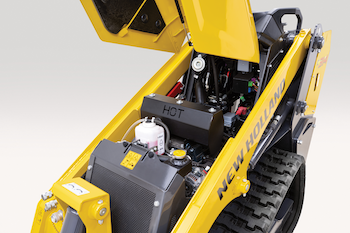 |
|
Ease of completing required maintenance throughout the life of the machine? is an important consideration, as is having a dealer that provides great customer service nearby, if needed. |
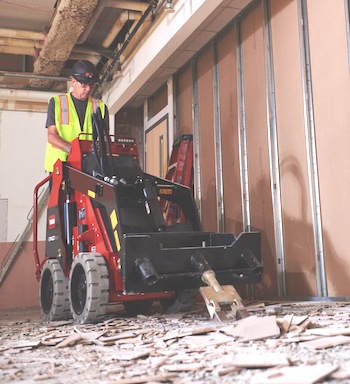 |
|
Toro Dingo models feature intuitive controls, making it simple for a homeowner or new construction crew member to rent and operate the machine with ease. |
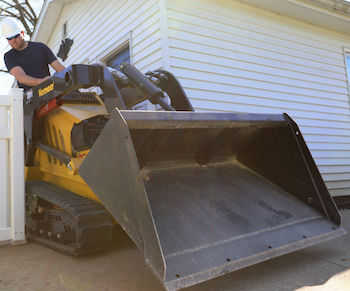 |
|
Mini skid steers offer a standing operator station, lower center of gravity and a compact footprint, making them excellent for ground-engaging activities and digging in confined spaces. |
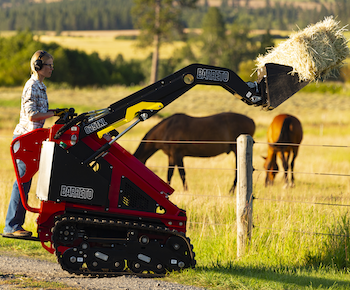 |
|
Beyond cost, fleet planners could consider their customer base and what past requests have been for certain pieces of equipment. Communication with the front desk is key, says Tim Phelps of Barreto Manufacturing Co. |
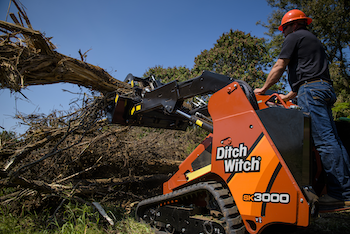 |
|
As the construction industry continues to face a worker shortage, renters are looking for ways that machines can support smaller crews. Machines with more power can fill the gaps by lifting loads that would otherwise require three or four workers to lift. |
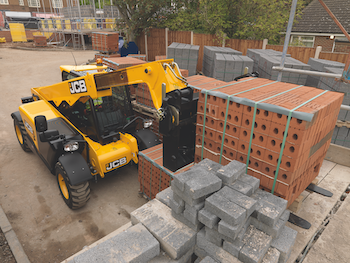 |
| JCB models range from 4,000- to 12,000-pound capacity and 13 feet to 66 feet in lift height. |
 |
|
ANDREW DARGATZ |
MATCH MACHINE TO THE JOB
Nearly all rental decisions fit specific needs to get a job done. Therefore, there isn’t truly a one-size-fits-all type of tool carrier. A wheel loader is one of the most versatile machines in a fleet and choosing the right wheel loader to rent depends on several factors:
- What the renter needs to get done
- Overall map of the job site
- Type of material to be moved/loaded
- Type of truck getting loaded
Correctly sizing a loader to a job site will help maximize productivity. If a job site is too tight, an oversized loader could produce slower cycle times; a larger job site may suffer from a small loader needing to make extra passes to fill a truck.
Medium-size wheel loaders, such as the LiuGong 838Hv, 848Hv and 856Hv, have several features and components that can benefit a rental center. With front and rear limited-slip differentials, these models enhance traction in wet or slick conditions. Better traction also results in reduced tire wear and faster cycle times.
Larger machines such as the 877H and 890Hv fit larger job sites better and will move more material with every pass. This means loading larger trucks faster or even pushing more snow farther on sites like airports or large distribution centers.
As customers continue to add electric cars and trucks to their fleets, rental centers should start to see an increase in demand for electric wheel loaders. To account for this increase, customers are outfitting facilities with charging solutions to support their on-road fleet.
Customers can leverage these same solutions to charge electric loaders. Having a charging solution in place will help the customer as they consider adding electric loaders to their fleet.
Additionally, electric loaders are a great solution for more regulated markets or sites that require high sustainable targets to hit. These loaders offer significantly reduced emissions and noise pollution.
Size is a key consideration in tool carrier selection. Overall, contractors most commonly purchase small- to medium-sized loaders which are more nimble, agile and versatile and can satisfy more customers. Small and medium loaders are ideal for rental centers.
These machines, when configured with quick couplers and auxiliary hydraulics, can be used with more attachments for customers to get more jobs done quicker. Offering attachments such as pallet forks, grapples and brooms creates greater demand and higher utilization and allows the rental center to charge higher rental rates.
Having the proper configuration for rental customers helps increase utilization and therefore the ROI for the rental center. Machines with quick couplers and auxiliary hydraulics allow customers to rent machines with attachments beyond just buckets. Attachments such as pallet forks, snow pushers, grapples and brooms allow the rental center to market to more customers.
Rental centers should be attuned to seasonality. Ensuring products rented out in the summer come back with enough time to turn them around for winter rental is one of the goals.
 |
|
JULIE PORTILLO |
ARTICULATED LOADERS FOR TIGHT-ACCESS JOBS
By design, small articulated loaders are versatile machines that offer a host of unique capabilities to benefit rental centers. Most notably, their central articulating joint offers a tight turn radius and the maneuverability to navigate small and challenging job sites.
Small articulated loaders are often underrated or even unidentified equipment solutions for small job sites where access is a challenge and where turf or surface damage is a particular consideration. Small articulated loaders leave minimal ground disturbance while providing relatively high-rated operating capacity for their size.
With a light footprint, impressive lifting capability for their size and unmatched maneuverability, it’s easy to see why the small articulated loader becomes a fast favorite and go-to machine of operators on various job sites.
To prepare for the use and overtime that renters may put on a small articulated loader, it is critical to implement a service plan. Outside of having a day-to-day maintenance checklist, owners should consider a longer-term maintenance strategy.
New and seasoned operators sometimes neglect one of the easiest, most impactful maintenance considerations for their equipment: the daily walkaround. Taking a moment to perform a pre-work inspection can make the difference between a productive day and a trip to the service shop.
For a small articulated loader, Bobcat recommends checking systems every 10 hours and before starting the machine. These walk-around points are covered in user manuals. In addition to daily maintenance checklist items, owners and operators should also pay attention to tasks that come up when the small articulated loader reaches 250, 500 and 1,000 hours or every 12 months, whichever comes first. It’s also spelled out in the operator manual.
For new and seasoned rental center employees, having formalized training and ongoing education is critical to support equipment longevity. Basic training should include:
• Equipment and attachments should have safety signs, instructional decals and an operation and maintenance manual that provides safety and instructional information.
• Regularly meet with employees to review maintenance and training materials along with a hands-on learning component so operators all have consistent information and expectations.
Small articulated loader attachments range from general, all-purpose material-handling buckets to heavy-duty application-specific or specialty attachments such as a stump grinder or log grapple. Every attachment has specific requirements for carrier size and auxiliary hydraulic flow. Make sure employees and rental customers understand the capabilities and limitations of the small articulated loader and any attachments they rent with the unit.
Small articulated loaders can be a great addition to your rental fleet, and following these recommendations can maximize your investment. •
 |
|
GEORGE MACINTYRE |
NO ONE-SIZE-FITS-ALL SOLUTION
Although tool carriers bring an extra level of versatility to the job site, the reality is there is no one-size-fits-all solution. But some machines can get you closer to all-around flexibility than others.
Each manufacturer may have different fit-up points and geometry on the front end of the machine, so an attachment from one brand may not fit up with another brand of machine. The exception to this would be skid steers and compact track loaders, which have a universal standard front coupler.
For backhoes and wheel loaders that don’t have that universal coupler, some models will offer more versatility than others. The new Case 580SV, for example, has a hydraulic front coupler available that can work with a large range of Case attachments, from a 6-in-1 bucket to pallet forks to brooms and more. It is self-leveling in both directions, making whatever tool that’s on the machine more effective.
When looking at attachment compatibility, rental centers and their customers don’t always need to limit selection to a single product line. Many compact wheel loaders have a skid steer interface plate that lets users hook up skid steer attachments. However, it’s important that a skid steer attachment is properly matched to the performance specs of the compact wheel loader.
When it comes to backhoes, going with a manufacturer that can offer a wide range of attachments for the back and front end is key. If you’re going to invest in a coupler system to make it a multi-purpose tool carrier, rental centers need to have a range of attachments available to capitalize on that investment.
Make sure it has auxiliary hydraulics in the front of the machine so users can take advantage of different front-end attachments. Too often, rental houses only offer a standard front bucket, which means they miss out on a chance to rent other applications.
Getting a good return on investment on tool carriers like backhoes can be a challenge for rental houses. The market is very competitive and they can’t increase backhoe rental rates beyond what the market will bear. This is why having a range of attachments and flexibility to use them is so important. Lower-cost attachments have healthier rental rates and offer a much better return.
With more attachments available for potential customers, rental houses can drive more demand for their machines because they are able to handle a wider variety of jobs. Customers need more ways to get work done, and they expect a higher level of capabilities from their machines. For example, many customers are now using backhoes with hydraulic thumbs on the bucket. With this attachment, they can pick up broken asphalt or concrete, a task that’s much more difficult to do with a simple bucket. By offering these attachments, rental houses aren’t just meeting expectations, they’re helping customers get work done faster, driving more rental opportunities and maximizing their machine investment.
 |
|
JERRY CORDER |
NEW MODELS ADD COMFORT, CONVENIENCE AND VERSATILITY
Customers are seeking advancements and efficiencies across the board for tool carriers, including increased comfort, operation upgrades for convenience and updated technology inside and outside the machine.
Kubota Tractor Corporation’s newest member to its compact track loader lineup is the SVL75-3, and its features bring solutions to each of these areas. The SVL75-3 comes with a new one-piece sealed cab that is quieter and engineered to keep dust, dirt and water out. Inside the cab, a new 7-inch touch- screen includes keyless start, integrated Bluetooth and digital displays for vital gauges. A new wide-angle reversing camera offers a 176-degree field of view on the touch screen.
The engine bay has been reconfigured with the radiator on top of the engine and the fuel tank in the door, allowing for unrestricted access to the battery, service filters and fluid fill points. An optional reversing fan sits on top the radiator to keep engine airflow unimpeded. Front and rear LED lights are now standard.
The Advanced Auto Downshift from Kubota’s line of excavators is standard on the SVL75-3. It automatically shifts from high to low speed when turning to ensure traction and improve operator convenience. Kubota’s Advanced Multi-Function Valve increases productivity by enabling simultaneous operation of the machine, the bucket and any other auxiliary hydraulic attachment.
Knowing the market you are competing in is always the most important factor for any business. Residential/weekend warriors’ rentals of this equipment is outpacing the professional contractors’ growth rate. An upside of bringing on a new compact track loader is the ability for these machines to work in a multitude of applications.
Rental centers should also keep the following in mind:
- Age and hours of current inventory
- Used market prices for equipment
- Market demand for track loaders in the area by size, weight and horsepower
- Local dealer support for new machines for warranty claims and parts availability
- Price/availability of new equipment
Using telematics is the best way for a rental center to increase ROI. These systems give rental centers a reliable way to track service and maintenance intervals and increase the longevity of their investments. Telematics can also alert rental centers when an error code is thrown on a machine. The ability to alert and track machine error codes allows a staff member to act proactively. Rental centers can contact customers and swap out machines and keep their customers working, reducing their downtime.
A service tech can generate a snapshot of the machine’s operating conditions during the time of error, allowing for faster service and repairs, which means less downtime.
Another useful benefit of telematics is the ability to geofence, which creates a virtual perimeter in a geographical area. A rental center can create custom perimeters around their facilities and can be alerted when a machine leaves or enters the designated perimeter. This can help decrease the risk of theft, or simply provide accurate timelines, enabling more accurate billing.
Rental centers can increase demand and ROI by eliminating downtime, ensuring that there are people and processes in place to eliminate inbound vs. outbound time. Committing to extraordinary customer service delivers ROI, which should include offering delivery trucks, road technicians, 24-hour hotlines, parts stocked to reduce dependency on dealer for day-to-day parts care, a sharp digital and marketing approach and up-to-date rental pricing. •
 |
|
CHRIS SLEURINK |
MULTI-FUNCTION TOOLS HAVE A LONG HISTORY
Multi-functional tool carriers have been around for some time. The Fendt GT series tractors introduced in 1953 is an early example. GT stands for Geräteträger and literally translates into tool carrier. It could carry a large range of interchangeable attachments allowing a farmer to do nearly all tasks with one machine. Similarly, the Germans introduced the Mercedes Unimog in the 1950s as a true tool carrier. The Germans were ahead of the tool carrier game!
There is a modern one-size-fits-all tool carrier, depending on the needs and wants of the customer. A mini skid steer or mini articulating loader can run dozens of tools, but keep in mind that such tool carriers won’t perform each task as well as a dedicated, purpose-built machine. For example, stump-grinding attachments for (mini) loaders underperform when compared to dedicated, self-propelled stump grinders. However, when one looks for a do-it-all machine with the intention of using a bit of each function like material handling, mowing, digging, trenching and other tasks, small skid steers and wheel loaders can be an excellent option.
If the target market is the consumer, size and weight are the first criteria. The tool carrier should be lightweight and compact, allowing customers to haul it on their own trailer/vehicle combination without CDL requirements.
Next, ease of operation is essential to provide the rental customer with a smooth and efficient service. It will cause fewer headaches for all parties. Third, parts and service availability are important, especially with the more specialized tool carriers or those coming from overseas.
Investigate local market needs; in some places, mini articulating loaders are becoming more popular than mini skid steers. Think about how often contractors need to go through 36- or 42-inch gates. If that is the case, one should consider acquiring machines built to that spec. Miniloaders.com offers the Intrepid articulating loaders with a dual wheel option that allows customers to go through 36- or 42-inch gates when needed.
Rental centers should not just purchase a tool carrier in the hopes of customers coming on the lot to rent it. Before acquiring one, the tool carrier should be marketed to a target customer base so renters understand its added value. It takes time and effort to change a local or regional mindset about what types of machinery to use for different job sites. •
 |
|
DORAN HERRITT |
MATCH MACHINE, ATTACHMENT TO CUSTOMER NEEDS
Rental equipment experts at New Holland don’t think there is a one-size-fits-all tool carrier. There are particular-sized power units and attachments that are most popular, but each customer has a unique need. Certain products will meet needs better than others.
For example, if a customer must work in a restricted area, he or she may need a mini track loader like the New Holland C314 or a small articulated loader, like the New Holland ML12. Likewise, a customer with a big job that needs serious hydraulic power and speed may rent a large compact track loader like the New Holland C362. The key is matching the customers’ needs to the power unit and attachment that will best work in the given situation.
Selecting the correct model for the tool-carrying task should consider the following criteria:
Serviceability. How easy is it to do daily service checks? Ease of completing required maintenance throughout the life of the machine? Very important: having a dealer that provides great customer service nearby, if needed.
Technology. Many manufacturers, including New Holland Construction, provide telematics for their power units to keep them safe and working at optimal levels. From location services to performance monitoring, this technology keeps rental units secure and delivering optimum performance.
One of the keys to ROI is keeping a machine running. Rental operators can be tough on machines and making sure they are serviced regularly will keep them running. Serviceability provides a better chance that service was done regularly; technology packages can keep your machine secure and allow rental center staff to see how the machine is performing every time a customer is using it. •
 |
|
KAITLYN INGLI |
MATCH TOOL CARRIER SIZE TO THE JOB
There is no one-size-fits-all type of compact utility loader (CUL). They come in various sizes, rated operating capacities and configurations. The choice depends on the scale of the job and the operator’s preferences. Different models may have different attachment compatibility, so the range of tasks they can perform varies.
Some models are designed for light-duty tasks, while others are more suitable for heavy-duty applications. For example, the Dingo TX 427 provides low ground pressure, making it easy on turf, and runs by three easy-to-use controls. This model would be ideal for a homeowner who has never rented a CUL. Meanwhile, those with larger jobs may find a Dingo TX 1000 fits the bill with its 1,000-pound rated operating capacity that can clear the side of a 30-yard dumpster or one-ton truck.
When a rental center is contemplating adding compact utility loaders to its rental fleet, there are several selection criteria that should be considered:
Demand/market analysis. Before acquiring CULs, assess the demand for these machines. Analyze customer inquiries, market trends and competitor offerings. Understanding the demand will help determine whether there is a viable market for CULs in your area.
Quality and reliability. Select CULs from reputable manufacturers known for its high-quality and reliable equipment. Reliability is crucial to minimize downtime and maintenance costs, ensuring customer satisfaction in the long term.
Maintenance and serviceability. Assess the ease of maintenance and service for the chosen CULs. Easy access to components, user-friendly maintenance procedures and the availability of spare parts are essential considerations to reduce downtime and maintenance expenses.
Easy-to-use features. Prioritize CULs with robust features, including excellent visibility, ergonomic controls and the ability to quickly swap out attachments. For example, the Toro Dingo models feature incredibly intuitive controls, making it simple for a homeowner or new construction crew member to rent and operate the machine with ease.
Attachment compatibility. Consider the compatibility of the CUL with a wide range of attachments, such as buckets, forks, augers and grapples. Versatility in attachment options can increase the machines’ utility and attractiveness to customers.
Cost of ownership. Analyze the total cost of ownership, including purchase price, operating costs, maintenance expenses and resale value. A well-balanced investment that considers long-term costs is crucial for profitability.
Customer feedback. Gather feedback from potential and existing customers to understand their preferences and needs. Customer input can help fine-tune your selection of CULs and improve your service offerings.
Customers are looking for rental centers to be experts when it comes to equipment and best practices. Rental center staff will want to be armed with the possibilities and limitations of the equipment to show that expertise and build customer trust.
Another way to increase the demand or ROI is to ask thoughtful questions surrounding the project the customer is hoping to complete. Good advice and transparency will go a long way to encouraging customers to come back when they start their next project. •
 |
|
KYLE NEWENDORP |
TOOL CARRIERS HAVE WIDE APPEAL
Tool carriers, including mini skid steers and compact articulated loaders, are versatile machines that appeal to a wide range of contractors. When selecting the right tool carriers to add to a rental fleet, consider demand and return on investment.
There is no tool carrier that fits all applications. Each type has distinct features and capabilities specifically designed to cater to different needs.
Compact articulated loaders, with their articulated steering, telescopic boom and high lift capacities provide speed, maneuverability, extended reach and minimal turf disturbance.
On the other hand, mini skid steers offer a standing operator station, lower center of gravity and a compact footprint, making them excellent for ground-engaging activities and digging in confined spaces. By understanding the requirements and tasks of contractors, rental stores can choose the most suitable tool carriers for their rental fleet.
When choosing tool carriers for a rental fleet, rental teams should consider:
Market demand. Rental teams should assess the popularity and demand for different tool carriers in their market.
Durability and reliability. Make sure the tool carriers are built to withstand the demands of rental usage and require minimal maintenance. Look for tool carriers from manufacturers with a track record of quality and durability.
Parts and service support. When selecting tool carriers for rental, assess the availability of parts and service support. A company’s reputation relies on maximizing the time equipment is available for rental. Select a company that has a demonstrated history of delivering exceptional support for its equipment after the sale.
Versatility and compatibility. Rental teams should consider the range of attachments compatible with the tool carriers. A variety of attachments can enhance the value and utility of the rental units, allowing contractors to tackle different tasks with ease.
To sustain high demand and maximize return on investment with tool carriers, rental teams can consider the following strategies:
Effective marketing. Rental teams should promote the benefits and versatility of tool carriers through marketing and educational materials. Raising awareness among contractors about how these machines can enhance their productivity and efficiency can drive demand.
Training. Provide customer training on how to operate the tool carriers effectively and utilize attachments. It can enhance customer satisfaction and encourage repeat rentals.
Flexible rental options. Offering flexible rental options, such as daily, weekly or monthly rates, can accommodate different project durations and budgets. It will attract a wider range of customers and increase rental demand.
Build relationships. Build strong relationships with contractors by understanding their needs and offering personalized solutions. It can result in increased rental demand and customer loyalty.
Regular updates. Rental teams should regularly update the rental fleet with models with the latest features. Customers are always looking for the latest technology and for optimal performance, so staying up to date can help attract more customers. •
 |
|
BRANT KUKUK |
TREND TO GREATER POWER AND VERSATILITY
We’re seeing renters look for more power and versatility from their compact track machines, or as we call them at Ditch Witch, stand-on skid steers. A contributing factor to this trend is that the construction industry is continuing to face a worker shortage, and renters are looking for ways that machines can support smaller crews. Machines with more power can fill the gaps by lifting loads that would require three or four workers to lift. Heavier machines can also haul heavier weight, reducing the time spent unloading a machine and helping crews move quicker through a project.
Additionally, manufacturers are incorporating versatile features into machines, such as new, innovative attachments to meet customers’ needs. With a wide variety of attachment options, contractors need just one machine and multiple attachments to complete almost any task. For example, if a contractor needs sitework, retaining walls, utility installation, landscaping and hardscaping, a stand-on skid steer can accomplish all of those tasks by simply switching out attachments.
With smaller crews and high demand, many contractors are taking on two or three different jobs in a day, so manufacturers are finding ways to build machines with more power and versatility to keep renters efficient and lead to higher profit.
When considering what new stand-on skid steer models to bring into a rental fleet, rental centers need to consider machine maintenance. They will want to bring machines into their fleets that require easy, minimal maintenance. When looking at new equipment, ask the dealer to point out the daily maintenance points and a proper maintenance schedule. This will help decide if your team will be able to perform this maintenance on schedule. On the other hand, if maintenance seems too time-consuming, continue to look for a machine that has a maintenance schedule that fits your team’s timeframe and abilities.
Proper, routine maintenance allows rental centers to make sure their stand-on skid steers are always available when they’re off rent. Additionally, minimizing the time spent on maintenance allows rental center employees to focus on helping customers select the right equipment for their unique jobs.
To help you increase ROI and maintain uptime, stand-on skid steers have been updated and designed for reliable, low-maintenance operation. Even tough equipment, however, can run into an issue when not properly maintained. To get the most of these machines, rental owners should follow best practices and perform regular maintenance.
One critical aspect of a mini skid steer maintenance routine goes beyond the machine itself and includes the upkeep of hydraulics and attachments. One key recommendation to keep in mind is that before a renter leaves with the machine, make sure that the flow rate of the hydraulic system matches what is needed to operate the attachment. An incorrect match can reduce the efficiency of the attachment by decreasing how quickly the machine operates or how well the attachment works.
In addition to matching the hydraulic system and the attachment, following routine maintenance best practices for attachments will improve efficiency and longevity. The first rule of thumb to ensure safe procedures is to read the operator’s manual, which is loaded with important safety and practical, machine-operation information.
From a compact landscape project to a larger-scale, heavy duty job site, stand-on skid steers provide great ROI to rental owners, especially when the equipment is at peak performance and reliable. •
 |
| TIM PHELPS Director of Sales and Marketing Barreto Mfg. Co. |
LOOK TO CUSTOMER REQUESTS FOR SELECTION INPUT
There are several considerations that will determine which tool carrier is the best fit. Optional attachments and overall size are main considerations that limit which jobs can be carried out with which machine.
Cost is a main consideration for rental fleet managers. Cheaper isn’t always better, and purchasing for ROI is a solid, long-game mindset for success.
Beyond cost, fleet planners should consider their customer base and their past requests for certain pieces of equipment. Ask the front desk about recent and historical requests, in which seasons they are being made, and for which units.
Consider the area you do business in; is it an area with many landscapers, or is it an expanding area with plenty of active construction?
Operator comfort and safety are top priorities for renters. Do they want a fully cabbed unit for use in extreme temperatures, or is a stand-on unit more fitting for the jobs at hand?
Consider the unit’s maintenance needs. Research specific features that may or may not require extra care and attention. Consider the mechanical crew’s skills and the time it takes to perform the needed maintenance.
Quality equipment and equipment education are two ingredients that help create demand and build trust with your customer base. People return to what they know, so ask questions to understand the job at hand and help guide them toward the proper equipment choice. Back that up with quality equipment that works seamlessly from start to finish, which can be achieved by purchasing quality units and practicing preventive maintenance that ensures the units are ready before they go out on rent.
Equipment education is vital. Instill confidence by teaching the customer the ins and outs of every feature on the unit. Get a feel for new customers’ hesitations or misunderstandings and speak to those points with clear instructions. It will position them for success and positions you as the trusted educational expert. New customers become repeat customers when they have a good experience with a product and the team behind it.
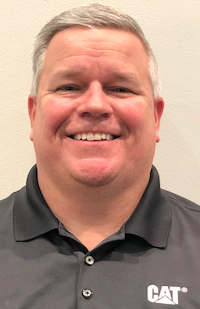 |
|
KEVIN COLEMAN |
ATTACHMENTS IMPROVE ROI
Cat skid steer loaders and compact track loaders take the role of tool carrier very seriously and Caterpillar designs machines to be performance-matched to even the most powerful and demanding tools yet be extremely safe and comfortable for the operator.
Tool carrier size will depend on the task at hand. Its size and auxiliary hydraulic capability will drive the size of the attachment and the level of productivity that can be expected.
Selecting machine size, type and how to equip them can be a challenge. Should the unit(s) be small, medium, or large chassis? Standard auxiliary flow or high flow? Rubber-tire skid steer or compact track loader? Enclosed cab or open canopy?
Each decision influences ROI via the acquisition cost, maintenance costs, rental rates and the compatible attachments that can be rented with the machines. In some locations, the focus is on small to mid-size skid steers and compact track loaders; but mid-sized skid steer and compact track loaders are also popular because of their high performance that is delivered in relatively compact chassis. This size is also easy to transport and can nimbly maneuver on tight job sites.
In some regions, fleet utilization is increased by including larger machines in the fleet with higher hydraulic horsepower for more demanding tasks.
Rental centers and customers are looking for ways to do more with their equipment. They are also looking for equipment that’s easy to maintain after rent, easy for the customer to maintain while on rent, and ways the equipment can be used without damage.
Machines with in-cab monitoring and messaging for routine maintenance is a huge benefit for the customer and the rental center. Routine maintenance items, such as cleaning/replacing the engine air filter, should be quick and simple without requiring bolts/panels removal. Other routine maintenance items, such as filters should be easy to locate and access without requiring removal of other components. Look at the access to check/add fluids, such as engine oil and hydraulic oil. All of these lead to improved maintenance of the equipment when on rent and quicker turnaround when the equipment comes off rent.
Rental centers are also recognizing the value that the track machine provides vs. a comparable-sized skid steer. Cat compact track loaders are well suited for a rental situation where it is difficult to control the application, material, maintenance and operating technique of their customers. The durable steel-embedded track and steel undercarriage components offer maximum life for rental centers. •
 |
|
LEE TICE |
FULL RANGE OF TOOL CARRIERS TO MEET RENTAL NEEDS
JCB offers a full range of tool carriers, providing rental customers with eight models to fit their specific needs. Models range from 4,000- to 12,000-pound capacity and 13 feet to 66 feet in lift height. JCB has additional options as well, such as a 5,500-pound capacity compact tool carrier with either a diesel or electric drivetrain. All tool carriers can be used with multipurpose attachments that can easily be interchanged.
JCB keeps both safety and technology in mind when designing every product range, and the tool carriers are no different. Every JCB tool carrier is designed with a U-pressed boom that has a low pivot point and keyway castings to disperse the forces of ground engagement. The boom’s low pivot point also provides the operator with 360 degrees of visibility.
The JCB LiveLink telematics system is standard with the full range of JCB equipment, including JCB telehandlers. JCB LiveLink provides operators real-time reports on the productivity, maintenance and security of the machine so they can run it efficiently and have it perform to its fullest ability.
The JCB cab stands out for its impressive size and ergonomic design. Its spacious layout ensures comfort and provides exceptional visibility, contributing to enhanced worksite safety.
The selection criteria for rental centers widely depends on the needs of their customers. That’s why JCB offers a variety of tool carrier models with a range of lift capacities. The range of capacities ensures that whatever the rental customer’s job requires, there’s a JCB tool carrier that can perform those duties efficiently.
One effective way to boost demand and ROI is to offer various attachments alongside the machines. JCB tool carriers are highly versatile, allowing operators to swap out attachments quickly. This provides rental customers with multiple tools from a single rental. Educating clients on these applications would also help increase business. This adaptability allows customers to be more productive.
This article originally appeard in the November-December 2023 issue of Pro Contractor Rentals magazine. © 2023 Urbain Communications LLC. all rights reserved.




